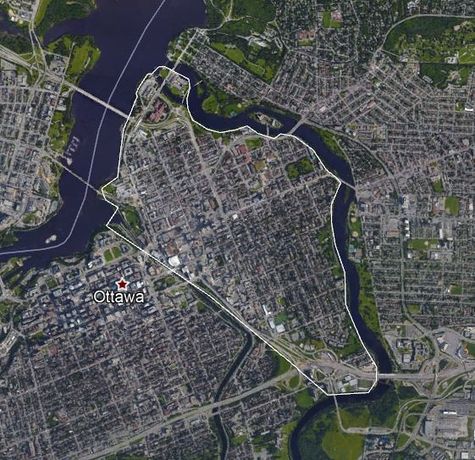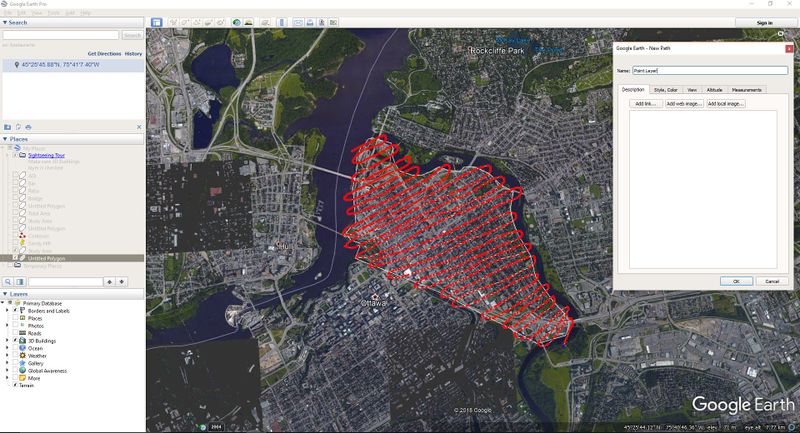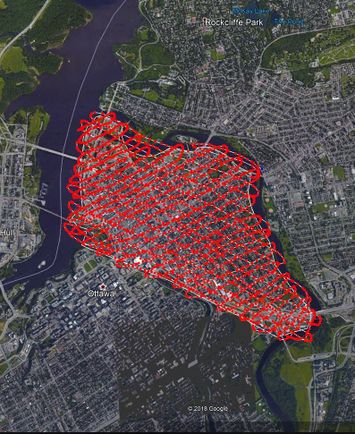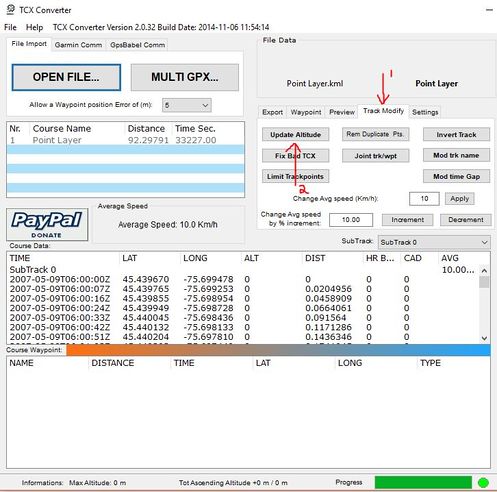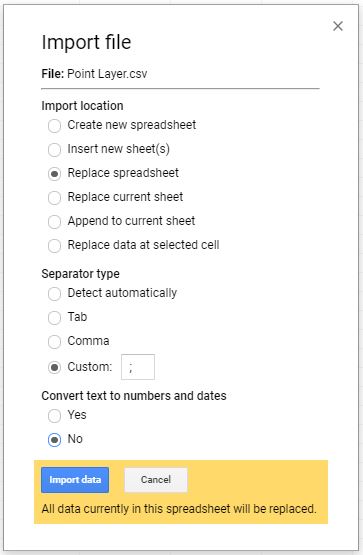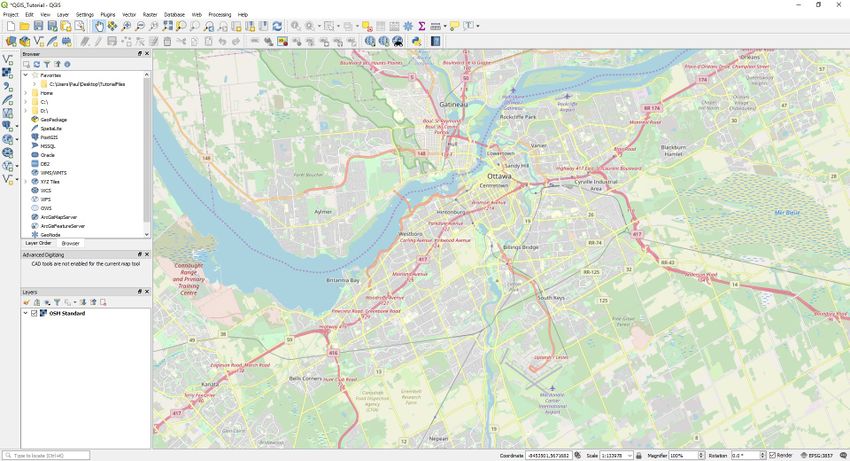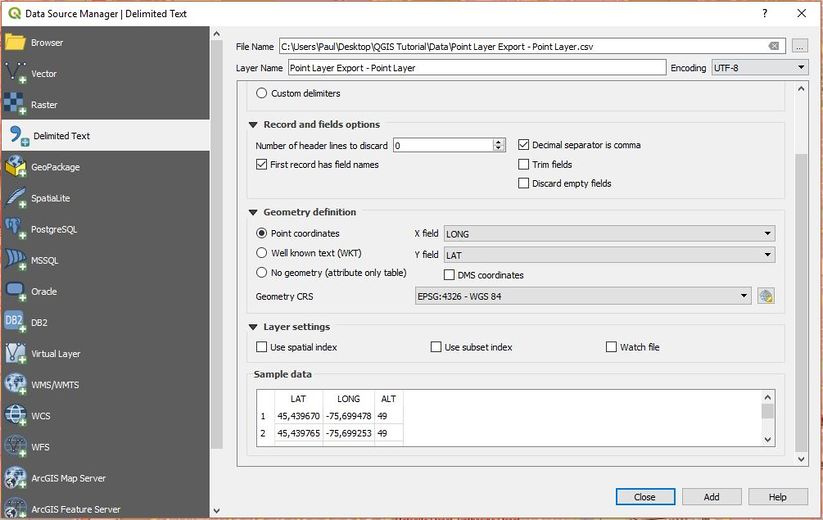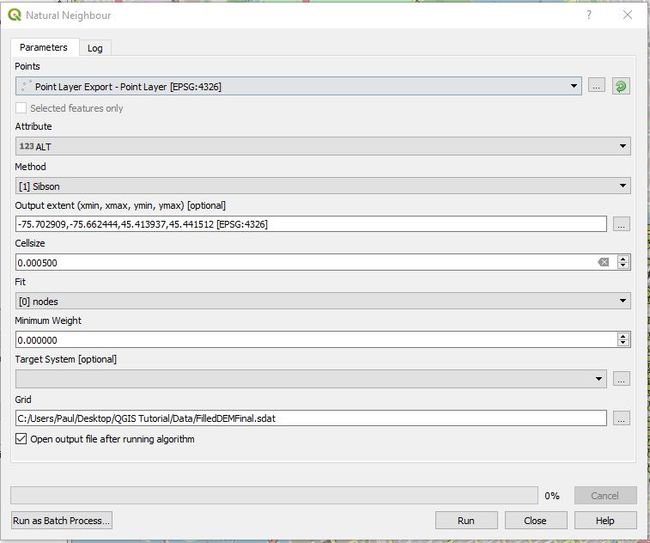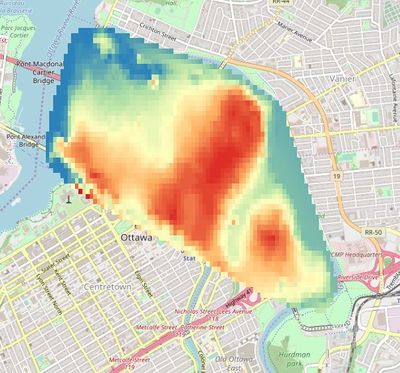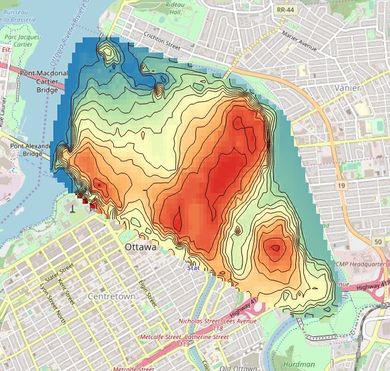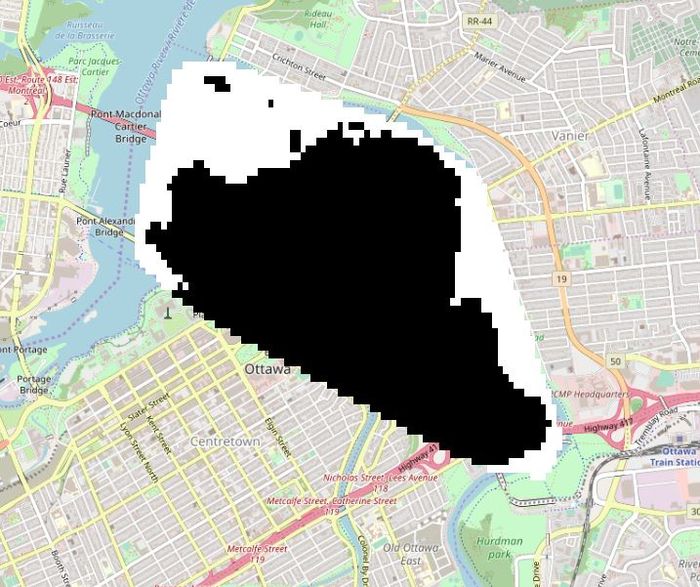Difference between revisions of "Data Extraction and Analysis Using Free and Available Software"
| Line 200: | Line 200: | ||
<div><ul> |
<div><ul> |
||
<li style="display: inline-block;"> [[File:8m_Rise.JPG|thumb|none|700px|'''13 Meter Rise''' Output from a rise of 8 meters above the river barrier, or a total of 13 meters of rise.]] </li> |
<li style="display: inline-block;"> [[File:8m_Rise.JPG|thumb|none|700px|'''13 Meter Rise''' Output from a rise of 8 meters above the river barrier, or a total of 13 meters of rise.]] </li> |
||
| − | <li style="display: inline-block;"> [[File:8 Rise2.JPG|thumb|none| |
+ | <li style="display: inline-block;"> [[File:8 Rise2.JPG|thumb|none|779px|]] </li> |
</ul></div> |
</ul></div> |
||
Revision as of 19:15, 17 December 2018
Contents
Introduction and Purpose
The use and manipulation of raster data is an integral part of GIS, and can play an important role within urban planning. This tutorial will demonstrate how to extract and utilize available raster data for all areas where data may not already be available (eg: rural towns). This is particularly important if you are working on a project where the information has not yet been created, or you want to double check questionable data. The tutorial will demonstrate the capabilities of open source software, and the many possibilities from the perspective of an urban planner, who may not have access to expensive subscriptions or information in certain areas or regions. You will be introduced to data extraction and analysis within the realm of planning, wherein it falls to the planner to find the best site for a home in an area surrounded by water and other fluvial processes -- it's important to check if the area is on a flood plain or low lying area as the chosen site is surrounded by the Ottawa River and Rideau Canal.
OpenStreetMap (through the QuickMapServices plugin) allows for the easy interpretation of which areas will be flooded, instead of the typical process of downloading urban footprints. More data is provided in a manner that is easier to both interpret and share, as viewers will have the context as the full spatial extent is provided.
Software
The links and descriptions for the software used for this tutorial are as follows:
- QGIS
- Version 3.4.2 'Madeira'
- QGIS is a free and open source GIS. This means that is a powerful tool that allows for the manipulation and analysis of spatial data, and can be downloaded by everyone.
- Download available here.
- Ensure that version 3.4.3, 64bit is downloaded.
- Google Earth Pro
- Software by Google that allows geospatial data to be extracted and manipulated.
- Available for download here.
- Google Sheets or Microsoft Excel
- Both Google and Microsoft have excellent software for spreadsheets. While Google Sheets is free, the majority of people have access to Microsoft Excel. Google Sheets was used for this tutorial, as all people will have access to this.
- 1. Google Sheets is available here. Google account is required (free), and there is no download necessary.
- 2. Microsoft Office is available here. Must be a student at Carleton University to qualify. If you do not have access this is not a problem, as Sheets functions very similarly.
- TCX Converter
- Free conversion software that allows for the rendering of altitude data from Google Earth data (.kml). This allows us to create a point cloud within QGIS.
- Download TCX converter here.
Getting Started and Setup
To begin, you must ensure that all software is downloaded and functional. Try running everything at least once before continuing. Once this is done, open up Google Earth Pro and locate Ottawa, or the area you would like to work with. The tutorial will be completed in the Lowertown/Sandy Hill neighbourhoods of Ottawa, found at the coordinates: 45°25'45.88"N, 75°41'7.40"W. This can be copied and pasted into the Google Earth search bar, and will put you between the two neighborhoods. Your extent should be similar to what is pictured below.
Once your study area has been located (again, it does not have to be the same as below) we will begin to use the tools within Google Earth Pro to create our study area. You'll want to navigate to Add Path in the Google Earth toolbar, pictured below.
At this point you will see the window for Add Path. You can provide a name to the layer, but this is not necessary. Begin to create a thatch pattern of points across the study area by holding down the left-mouse button, similar to what you see below. The closer you get the more precise the interpolation will be (to be completed at a later step). This step takes some time, but provides the necessary data for the creation of a raster layer in QGIS. When all your points have been laid out, navigate to Altitude, and ensure Clamped to Ground is selected. When this is done, hit Ok.
At this point you will have your points and area selected for extraction. Follow these steps:
- Right-click on your point layer.
- Save Place As -> .kml
- Name the file whatever you want (eg: Point Data), and ensure you save it to your working folder.
Conversion
Now that we have our points, these need to be ran through the conversion software in order to extract the altitude data from the Google Earth .kml, and then convert to a .csv file. Open TCX Convert, which was downloaded in section the earlier section, titled Software. If it is not downloaded, do so now as it is necessary to complete this tutorial.
- In the top right corner of the tool, change the language to English, or your preferred language if it is not already set.
- Open File -> your point file (.kml)
- You will notice the altitude column is 0 at this point.
- Navigate to Track Modify in the window near the top right, and then Update Altitude, and click Yes (See the image below).
- Once the progress bar has completed, navigate to Export, found in the same area as Track Modify.
- Export the file as .csv to the same folder as your other data.
The next step will be to import this .csv file into Google Sheets or Microsoft Excel -> Sheets will be explained here due it being free and accessible, as well as having slight more steps to Excel.
Spreadsheets
Open your browser and click here to head to Google Sheets. Once there, open a new sheet and navigate to:
- File -> Import -> Upload -> Select a file from your computer
- Select the 'Point Data' file, and match the image below (ensure you do not forget the semicolon for the separator type):
This will bring the .csv into Sheets, and allows for the irrelevant data to be deleted, so it can be exported once more.
- Delete all columns aside from LAT, LONG, and ALT
- File -> Download as -> Comma separated values (.csv). When saving it, ensure that you change the name slightly so you import the correct file in the next step.
Note: If using Excel, this can all be done by simply opening the .csv and deleting the required columns. Without Excel, this is where Sheets is useful as the .csv will appear as plain text instead.
QGIS
Quick Map Services
When your file has been exported as a .csv, it's ready to be brought into QGIS. Before that however, a basemap will be brought in using QuickMapServices, a plugin that simply allows for a quick basemap to be imported, such as OpenStreetMap, a highly detailed basemap that is continuously updated.
- Open up QGIS.
- Navigate to the menu toolbar at the top of QGIS
- Plugins > Manage and Install Plugins > All Plugins
- Enter QuickMapServices into the search bar, and then Install Plugin
This will download the plugin and create the following on the vector toolbar (the second one):
- Click on the icon outlined in red, which will open up the QuickMapServices plugin.
- OSM > OSM Standard
This will create the layer OSM Standard in the layers tab.
Importing the Point Layer
Now the raster data can be created. Begin by navigating to the Manage Layers Toolbar, and to the icon displayed below:
This allows for the import of the .csv into QGIS, where it can be used to create a DEM or other raster data. It is important at this stage to ensure that all selections made below are the same as what is listed/seen in the image below.
'Select:'
- Delimited Text tool > Select the file using the three dots to the right of File Name.
- Under File Format select CSV
- Ensure 0 fields are discarded, and the "First Record has field names" box is checked. This maintains the column headers, and Decimal separator is comma is checked.
- The Geometry Definition settings are very important, so check that Point Coordinates is selected.
- After this, ensure the following is set: X == LONG, Y == LAT and Geometry CRS == EPSG:4326 - WGS 84, or the projection you have decided to use based on your selected area.
When your Delimited Text window looks the same as the image below, and the Sample Data is the same then click Add and the point layer will be created.
At this point you will have a series of points within QGIS that have the atrributes of Longitude, Latitude, and Altitude. This can be used to create Raster data using interpolation methods, allowing you (the user) to analyze/extrapolate a large amount of data. We now have all of the necessary information extracted, converted and imported into QGIS.
Interpolation
The processing toolbox will be used in order to turn the point/elevation data into a DEM.
Navigate to the top of the QGIS window, and select:
- Processing > Toolbox - This brings up the processing toolbox, wherein the necessary tools can be located.
- SAGA > Raster Creation Tools > Natural Neighbour
This is a form of interpolation that will benefit from a denser cluster of points. To create a natural neighbour interpolation, fill in the following parameters:
- Select the point layer imported in the previous step using Browse.
- Under the Attribute field, select the Altitude (ALT).
- For the Method, select Sibson.
- Output Extent > Use Layer/Canvas Extent > Select the point layer. This will fill in the extent to stop at the boundary of the point layer, and will extend to the furthest points around the perimeter.
- Cellsize == 0.0005
- Under Grid, create a new save of the interpolation file, and then 'Run Natural Neighbour - See below for the outputs
- Right click on the layer 'Grid' > Properties > Render type == Singleband Pseudocolor.
- Rick click on the colour ramp (the bar and not the text), and invert it, providing a blue (low) to red (high), and demonstrating the elevation differences.
Optional Step - Create Contours
- Another step to visualize the data is to create contours of the raster layer. Navigate to 'Processing Toolbox (in the previous 'text block') > GDAL > Raster Extraction > Contour'
- Select the Grid created from the nearest neighbour tool as the input layer, set the intervals to 2 metres (depending on the scale of your area), and click Run in Background.
Flood Analysis
At this stage, we can begin to run different flood scenarios on the downtown sample area chosen. This could be a very important tool when deciding where to build, and would have been incredibly useful when combined with soil types in areas such as Old Ottawa South, where many houses are built upon a floodplain. To understand what is going on the background, when extracting from Google Earth, you are provided with a graph/representation of the elevation data by right-clicking on the point layer you created, and selecting Show Elevation Properties. This tells us the minimum elevation is 40m, median is 62, and maximum elevation is 84. This is relaative to the river, where we can think of it as being 0 metres. Profile for chosen sample area:
Navigate to:
- Raster > Raster Calculator
- Fill in the following, where the layer name is your grid/DEM, and the number for the meters is calculated based on how many meters you are checking past the lowest point - i.e. "Layer Name" <= 57 = All points less than or equal to 8 meters above the barriers along the river (49 meters) and around 13 meters higher than the average elevation of the river (checked via Google Earth).
- Grid <= 57
- This can be done for any number of elevations, and will demonstrate a simple method of analyzing elevation.
Example and Uses
This section will demonstrate a brief example of an area that would rely on this form of Google Earth point extraction, and would benefit from understanding the exact flood analysis as it is situated on a large amount of swamp land in Northern Ontario. No elevation data covering the required extent could be accessed.
